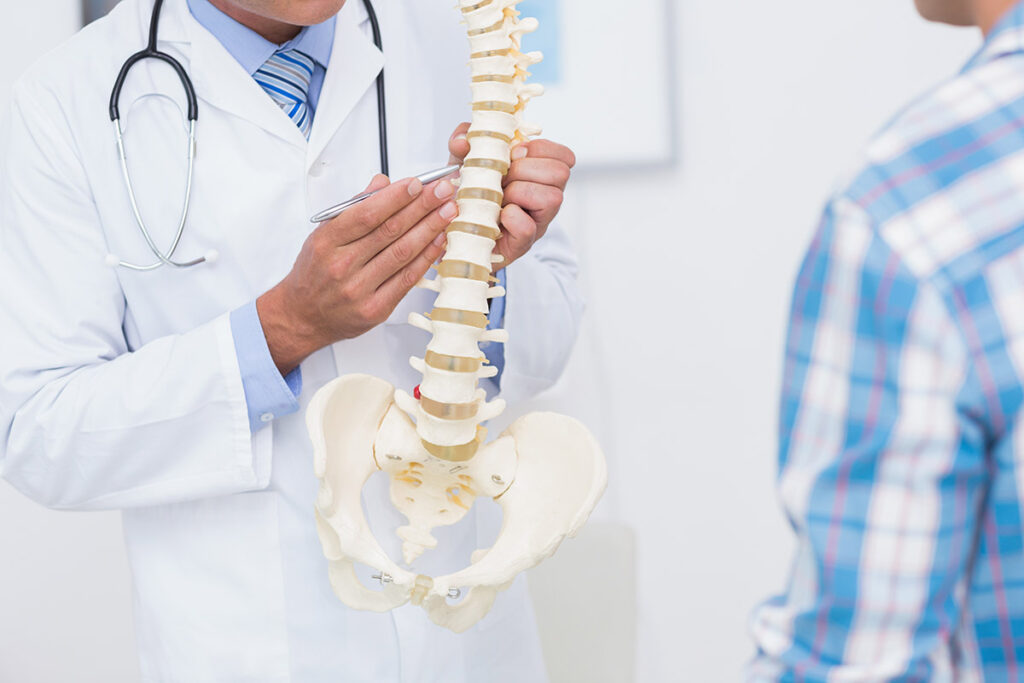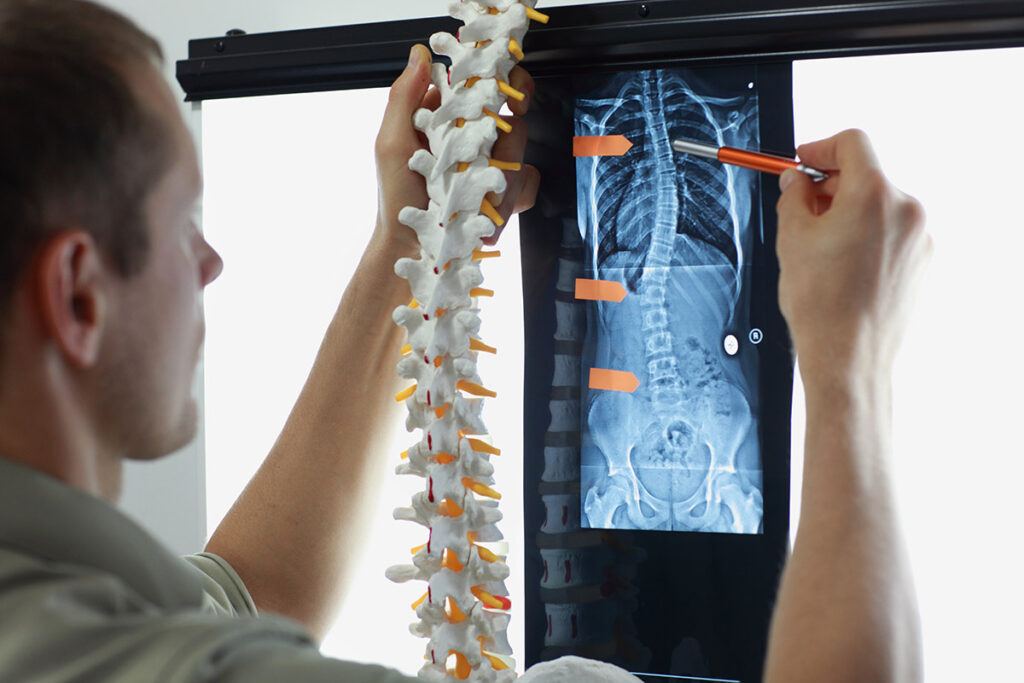

Spine
GENERAL INFORMATION
The primary role of the spine is to support the body and enable twisting, walking, and movement. It comprises disks, nerves, vertebrae, and the spinal cord, collectively forming the body’s central support structure. While various conditions, diseases, and types of injuries can impact the spine, numerous treatment and surgery options are available for addressing spinal problems.
The spine connects different parts of the general musculoskeletal system, facilitating activities such as standing, walking, sitting, twisting, and bending. A healthy spine possesses three natural curves that create an S-shape, absorbing shocks to the body and protecting against injury. It is a highly intricate system composed of various components:
- Vertebrae: The spine comprises 33 vertebrae, small bones stacked to form the spinal canal—a tunnel safeguarding the spinal cord and nerves from injury. While most vertebrae are movable, the lowest ones are fused together and immobile.
- Intervertebral Disks: These are flat, round cushions situated between the vertebrae, acting as shock absorbers for the spine. Constantly under pressure, these disks are soft and gel-like at the center.
- Facet Joints: Spinal joints with cartilage enable the vertebrae to slide against each other, providing greater flexibility and stability. They also permit the body to twist and turn.
- Spinal Cord and Nerves: The spinal cord is a column of nerves traversing the spinal canal, extending from the skull to the lower back. Thirty-one pairs of nerves branch out through vertebral openings to convey messages between the brain and muscles.
- Soft Tissues: Ligaments connect the vertebrae to the spine, holding it in position. Additionally, muscles supporting the back and aiding movement, along with tendons connecting these muscles to bones, are crucial components.
Spine Conditions & Injuries
Spinal injuries and conditions are not necessarily easy to develop or inflict, but they constitute a complex area of study. For instance, the cervical spine is vulnerable to injury due to its mobility and susceptibility to sudden movements or high-energy impact; however, the spine itself is quite robust.
A variety of spine injuries and conditions can develop from different circumstances, including trauma, disease, and age-related issues:
- Spinal Cord Injuries: These may result in conditions such as paralysis, herniated disks, and spinal fractures.
- Spine Tumors: These tumors can be either cancerous or benign.
- Spine Infections: Conditions such as meningitis and osteomyelitis fall under this category.
- Spinal Defects: Examples include spina bifida.
- Bone Spurs: These are jagged edges on the vertebrae that exert excessive pressure on the spinal cord and nerves.
- Back Sprains and Strains: Common injuries that affect the muscles and ligaments of the back.
- Spine Arthritic Conditions: Examples include ankylosing spondylitis.
- Osteoporosis: A disease that weakens bones to the point where they become susceptible to sudden fractures.
- Problematic Curvatures of the Spine: Conditions such as scoliosis and kyphosis fall into this category.
- Neuromuscular Diseases: Conditions like amyotrophic lateral sclerosis.
When to See a Spinal Specialist
Consider consulting a spine specialist if you are experiencing persistent or severe back or neck pain, along with other symptoms or conditions related to the spine. Here are some signs that warrant a consultation with a spine specialist:
- Persistent Pain: If you have been experiencing persistent back or neck pain for an extended period, especially if it interferes with your daily activities.
- Radiating Symptoms: If you experience pain, numbness, or tingling radiating down your arms or legs.
- Recent Injury: If you have had a recent injury to your spine or neck, seeking specialist evaluation is crucial to assess the extent of the damage.
- Changes in Bowel or Bladder Function: Any sudden changes in bowel or bladder function could be indicative of a serious spinal condition and should be evaluated immediately.
- Leg Weakness or Walking Difficulty: Weakness in your legs or difficulty walking should prompt a visit to a spine specialist.
- History of Cancer: If you have a history of cancer and are experiencing new back pain, it’s important to rule out the possibility of spinal metastases.
- Unexplained Weight Loss: If you are losing weight without trying and experiencing back pain, it could be a sign of an underlying condition that requires attention.
- Noticeable Spinal Changes: Noticeable changes in the alignment of your spine, your posture, or the development of a hump may indicate a structural issue that needs evaluation.
It’s important to note that your primary care physician may refer you to a spine specialist if they believe it’s necessary based on your symptoms and medical history.
Treatment Options
The approach to treating spine injuries or conditions depends on the type, severity, and the patient’s overall health. Various surgical and non-surgical treatments are available for different spine conditions, with specialists typically starting with conservative measures:
- Injections: These include epidurals, facet joint, sacroiliac joint, and steroid injections, aiming to reduce inflammation, pain, and degeneration.
- Nerve Blocks: Another type of injection, targeting nerves rather than joints, effectively blocking pain signals to the brain.
- Joint Aspiration: This procedure involves using a needle to remove fluid from the joint, decreasing pressure, relieving pain, and improving range of motion.
- Back Braces: Utilized to enhance stability and provide comfort.
- Physical Therapy: A vital component of conservative treatment.
When conservative approaches prove ineffective in treating or alleviating back pain, surgery may be recommended. Surgical options include:
- Vertebroplasty and Kyphoplasty: These surgeries repair compression fractures of the vertebrae.
- Spinal Decompression: Involves removing the bony walls of the vertebrae and any bone spurs to open up the spinal column and alleviate pressure.
- Discectomy: Used to remove a herniated disk, often performed alongside a laminectomy.
- Foraminotomy: Enlarging the bony hole where the nerve root exits the spinal canal, helping to prevent bulging disks or thickened joints from pressing on the nerve.
- Spinal Fusion: Involves removing the spinal disk between two or more vertebrae, fusing adjacent vertebras using bone grafts and metal devices secured by screws.
- Artificial Disk Replacement: An alternative to spinal fusion, it replaces severely damaged disks with synthetic ones.
Common Conditions
And more…
Our specialties extend beyond what you see here. If you have a special need, make an appointment with us!


